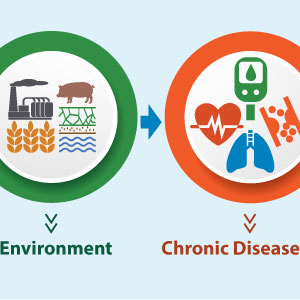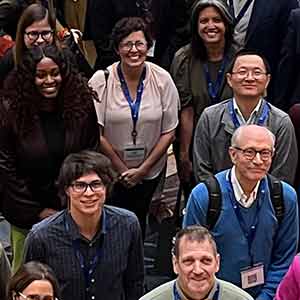Ethical, legal, and social implications (ELSI) of researching how the environment interacts with human genetics were the subject of a virtual workshop co-sponsored by NIEHS and the National Human Genome Research Institute (NHGRI) Jan. 11-12.
The purpose of the meeting was to discuss ELSI issues that will require greater attention as gene-environment interactions research expands, noted Dave Kaufman, Ph.D., a program director in the NHGRI Division of Genomics and Society. He and Kimberly McAllister, Ph.D., a health scientist administrator in the NIEHS Genes, Environment, and Health Branch, organized and moderated the event.
 Kaufman, left, manages ELSI research grants, and McAllister, right, manages grants in genetic epidemiology and gene-environment interactions studies. (The photo of Kaufman is courtesy of NHGRI, and the photo of McAllister is courtesy of Steve McCaw / NIEHS)
Kaufman, left, manages ELSI research grants, and McAllister, right, manages grants in genetic epidemiology and gene-environment interactions studies. (The photo of Kaufman is courtesy of NHGRI, and the photo of McAllister is courtesy of Steve McCaw / NIEHS)ELSI topics discussed at the workshop included collection, analysis, and sharing of environmental and genomic research data; unique concerns of vulnerable populations disproportionately affected by environmental exposures; and potential legal and privacy issues that arise when individuals’ identities are linked to genomic and exposure data.
Complex and multifaceted
“Our work is complicated,” said NIEHS and National Toxicology Program Director Rick Woychik, Ph.D., noting that the environment includes not just chemicals and pollutants but also lifestyle factors, psychosocial stress, racism, and socioeconomic disparities. “We are interested in evaluating how all of these environmental exposures impact human health.”
Gene-environment interactions research promises better understanding of why individuals experience different biological responses to exposures, but such inquiry demands careful attention to issues that often go beyond the bench, according to Woychik.
 Green said that as gene-environment interactions research continues to grow, greater attention to ELSI will be required. (Photo courtesy of NHGRI)
Green said that as gene-environment interactions research continues to grow, greater attention to ELSI will be required. (Photo courtesy of NHGRI)“The ethical, legal, and social issues related to gene-by-environment interactions research — and the implications of this research — are increasingly complex and multifaceted,” he said.
That sentiment was echoed by NHGRI Director Eric Green, M.D., Ph.D., who pointed out that his institute emphasizes responsible data stewardship and consideration of ELSI.
“It’s an opportune time with respect to the science and exciting technological advances that might provide us [with] more robust approaches for dissecting the interactions of genetic influences and environmental influences,” said Green. “We know that we must incorporate the environmental factors that lie on the same causal pathways as genomic determinants, and we have learned that as genomics grows, new issues and implications arise.”
Sharing findings with communities
Gene-environment interactions research relies on individual- and community-level information about genetic characteristics and environmental exposures, and that has led to calls for increased communication of findings with study participants.
“This has created new responsibilities for researchers to report back to people to help them use this information to learn about their environmental health risks and have the opportunity to modify [environmental] exposures,” said Julia Brody, Ph.D., executive director and senior scientist at the Silent Spring Institute.
 Korfmacher aims to translate environmental health sciences research into policy at the local, state, and federal levels. (Photo courtesy of Steve McCaw / NIEHS)
Korfmacher aims to translate environmental health sciences research into policy at the local, state, and federal levels. (Photo courtesy of Steve McCaw / NIEHS)A National Academy of Sciences, Engineering, and Medicine report published in 2018 concluded that sharing research results with participants and communities should become routine in most circumstances, to help promote transparency, trust, and mutual benefit.
Appropriate communication of study results requires thinking about the entire research-to-policy translational system, noted Katrina Korfmacher, Ph.D., from the University of Rochester Medical Center.
“The first question I always ask is ‘So what?’” she said. “How can we best share research results with everyone — from individuals to policymakers — in a way that will enhance their capacity to address the root causes of environmental exposures and inequities?”
Diversifying the research enterprise
The need for greater diversity in study participant pools also was a major topic at the workshop.
Karriem Watson, D.H.Sc., chief engagement officer for the National Institutes of Health All of Us Research Program, noted that the initiative is collecting health, environmental, and genomic information of 1 million or more U.S. residents, with a specific focus on diversity, equity, and inclusion.
 Watson said that race, ethnicity, age, education, income, and sexual and gender status are diversely represented in the All of Us Research Program. (Photo courtesy of Karriem Watson)
Watson said that race, ethnicity, age, education, income, and sexual and gender status are diversely represented in the All of Us Research Program. (Photo courtesy of Karriem Watson)“It is so important for us to think about the fact that we are building one of the nation’s largest cohort studies,” Watson said. “Early on, we wanted our participants to reflect the diversity of the U.S., and we have been intentional to engage stakeholders as partners to ensure community-engaged principles of ethical inclusion.”
Kaufman noted that going forward, gene-environment interactions research will require balancing the interests of scientists and study participants; consideration of the time and resources necessary for community-based methods that build research based on stakeholder input; and the incorporation of hypotheses that consider social determinants of health.
(Jennifer Harker, Ph.D., is a technical writer-editor in the NIEHS Office of Communications and Public Liaison.)









